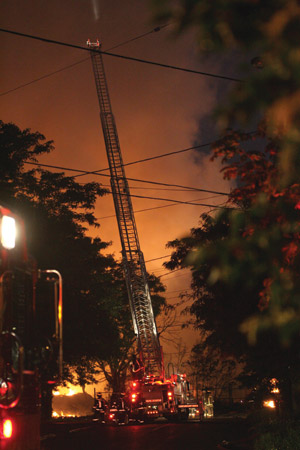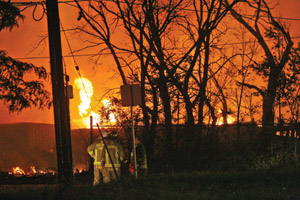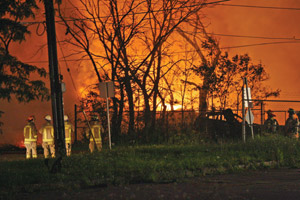
Features
Hot topics
Incident reports
Propane blast
Toronto Fire Services multi-level response praised by observers of massive explosion and fire
September 18, 2008
By
Laura King
Toronto Fire Services multi-level response praised by observers of massive explosion and fire
 Firefighters from Toronto Fire Services work to cool down the area surrounding a propane explosion and fire on Aug. 10. |
Just six months after Toronto Fire Services battled one of the biggest infernos in the city’s history on Queen Street, another six-alarm blaze tested the mettle of the more than 100 firefighters who responded to the Sunrise Propane Industrial Gases explosion that rocked the Ontario capital on Aug. 10.
By all accounts – blogs, news stories, and politicians quoted on 24-hour news stations – Toronto Fire executed a textbook response to the 3:50 a.m. alarm, with 34 apparatus and 125 firefighters on scene.
One news report said Toronto’s emergency management plan was activated shortly after the explosion in North York, “which sent fireballs into the air, shook scores from their bed, was heard across the city and was visible as far away as Niagara region.”
“The response was quarterbacked at an operations centre by city manager Shirley Hoy and her deputy, Richard Butts, who were in contact with police, fire and ambulance services on the front lines.
TFS Deputy Chief Jim Shelton was the incident commander at the scene, working alongside two division commanders and another deputy chief. Deputy Chief Darryl Fuglerud was at communications and reported to the Emergency Operations Centre when it was activated by the city manager. TFS Division Cmdr. Bob O’Hallaran was the liaison between the Toronto police and the fire service.
 The Technical Standards and Safety Authority made legal applications on Aug. 22 to permanently shut down Sunrise Propane. |
A National Post blogger described the response this way: “Crises measure an organization’s virtues, strengths, capabilities and leadership. In the aftermath of last Sunday’s spectacular propane blast that forced more than 12,000 Toronto residents from their homes and led to two deaths, observers have a much clearer picture of what works in Canada’s largest city and what is in desperate need of repair.
“The City’s emergency services undoubtedly deserve the respect afforded them by Torontonians. Police, fire and other emergency officials answered the call to evacuate the area around the explosion and contain the fire that destroyed the Sunrise propane facility with speed and professionalism. They saved lives.”
That said, political fallout has overshadowed the response to the incident and the line-of-duty death of TFS District Chief Bob Leek, who was found near the scene with vital signs absent, and a young Sunrise worker whose body was found at the site.
In light of the political hand wringing over the fact that a massive propane facility was allowed to set up shop in the heart of a residential neighbourhood, Toronto Fire Services and other agencies were effectively gagged by the city in its attempt to manage the message. No wonder. Lawsuits have been filed. Asbestos was found near the site, having blown out of nearby schools. A 16-kilometre stretch of Highway 401 was closed for the better part of the day, something Ontario Provincial Police spokesman Cam Wooley told The Canadian Press he hadn’t seen in 30 years on the job. A partial no-fly zone was established in the air. Residents who lived close to the site were literally blown out of their beds. More than 10,000 people were evacuated. People were angry; the media was hungry for details and Mayor David Miller was out of town.
“The city has taken control of any outside information going out because it’s bigger than just a situation that the fire service can control,” said one TFS spokesperson. “That’s why the city is taking control, including their strategic communications staff.”

Toronto firefighters survey the site of Sunrise Propane Industrial Gases. Thousands of Torontonians were evacuated from their nearby homes.
|
Meanwhile, Deputy Chief Shelton and other TFS personnel remained on scene for several days after the blast to support the investigation.
“Time of day saved us,” Shelton told reporters that Sunday afternoon before the city clamped down on news coming out of the site, noting that few people were out or working nearby at 4 a.m. on Sunday.
Several days after the incident, crews hadn’t pieced together what caused the explosion and fire. Division Cmdr. Bob O’Hallarn said in an interview on Aug. 18 that the Office of the Fire Marshal was still on scene.
The OFM was investigating along with Toronto police, the Technical Standards and Safety Association, the coroner’s office, the Ministry of Environment (because of the discover of asbestos) and the Ministry of Labour.
As of press time in mid-August, 70 homes remained off limits and six were thought by officials to be uninhabitable.
O’Hallarn was the calm and level-headed voice of the Toronto Fire Services on the day of the explosion, facing TV cameras and reporters in several news conferences.
“There was a very, very large amount of fire when we arrived and the extent of the explosion, if the blast was heard as far away as it was, could have been much more serious,’’ he said.
Later in the day O’Hallarn said there were propane tankers still burning at the site.
“We’re working on cooling those down,’’ said O’Hallarn. “And we’re evacuating the area as a precaution.’’
Toronto Fire Services spokesperson Capt. Adrian Ratushniak described the cooling operations to The Toronto Star:
“We cooled the cylinders off with copious amounts of water and left anything that (was) burning on the top to burn off,” he said.
“You’re best off controlling the fire where you can see it, rather than turn it out and let the gas spread.
“If there’s a fire under one of these propane cylinders, it will warm up that cylinder and bring it to a point where it is boiling and if there is a slight crack in that cylinder then the likelihood is that you’re going to have an explosion.”
Ratushniak said because of the risk of explosion, firefighters set up unmanned hoses near the tanks then withdrew a safe distance and monitored the cooling process.
The initial explosion was most likely a blevy, something TFS worked through the rest of the day to prevent. The tanker trucks were still burning at 12:30 p.m., more than nine hours after the first early morning explosion.
O’Hallarn said during the interview that Toronto Fire’s planning for this kind worked meticulously.
He said first in Deputy Chief Dan Antle’s decision to evacuate the area around the Sunrise Propane site was key.
“I believe the planning did work,” O’Hallarn said by cell phone from the Murray Street site. “Our initial resources were concentrated on getting those people out of that area. There were still people in area and they didn’t really now what to do.”
O’Hallarn said when he arrived on Murray Street, between 4:30 and 5 a.m., “there was still a lot of flame.”
Various reports said there wasn’t enough water near the site so firefighters ran hoses from locations up to a kilometer away. O’Hallaran said the magnitude of the site and the extent of the fire likely meant water had to be brought in.
Acting Fire Chief Roy Law told reporters on the night of Aug. 10 that after more than 16 hours of battling a series of blasts at plant the blaze was under control.
The City of Toronto was still in damage-control mode at press time, saying it has little control over the location of companies such as Sunrise Propane due to zoning regulations that preceded amalgamation. Sunrise, which is based in the former city of North York, had previously been cited for unsafe practices but the company had also been told by municipal officials in 2004 and 2006 that its plant met the zoning requirements.
Still, editorials in Toronto newspapers have called for the city to adopt tougher zoning regulations and have questioned the city’s rationale for not doing so sooner.
“It was six years after amalgamation that Sunrise operators first came to the city, asking if their propane plant fit the rules,” The Toronto Star said. “That was enough time to bring North York’s overly loose bylaw in line with stricter zoning elsewhere in Toronto – if only it had been made a priority. With those changes in place, Sunrise owners could well have been rejected in 2004. True, they could still have taken their case to court, or the Ontario Municipal Board, but the city would at least have taken a stand.
“Miller has responded to the crisis by launching a review of where the city stands, including what new powers it might deploy under the City of Toronto Act. One hopes action will be swift.”
Print this page
Advertisement
- Trainer’s Corner: The need to practise mayday
- Cornerstone: Leadership strategies from best of the best